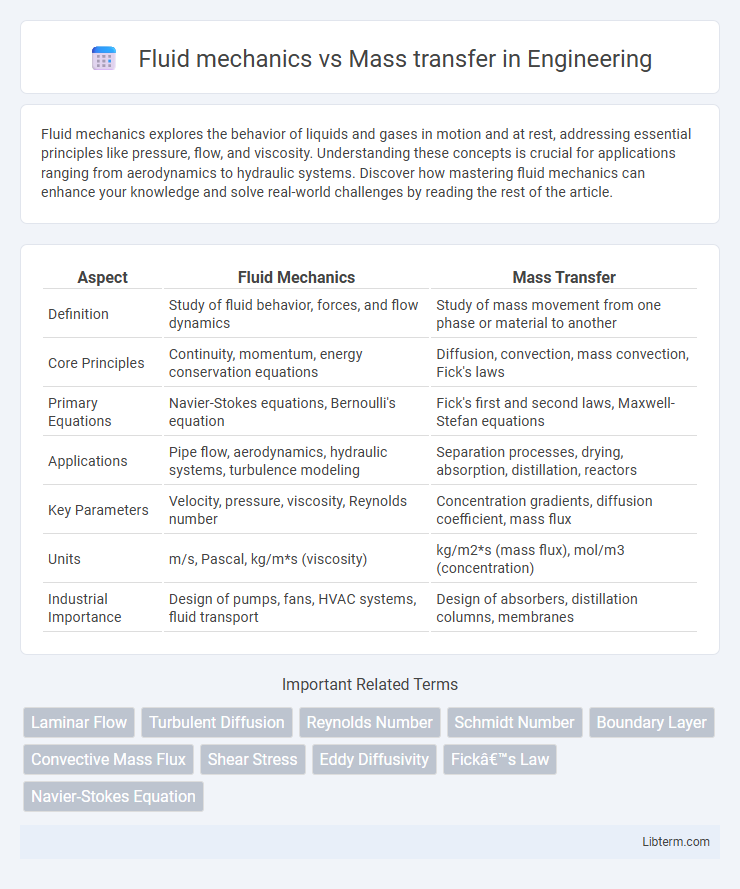Fluid mechanics explores the behavior of liquids and gases in motion and at rest, addressing essential principles like pressure, flow, and viscosity. Understanding these concepts is crucial for applications ranging from aerodynamics to hydraulic systems. Discover how mastering fluid mechanics can enhance your knowledge and solve real-world challenges by reading the rest of the article.
Table of Comparison
| Aspect | Fluid Mechanics | Mass Transfer |
|---|---|---|
| Definition | Study of fluid behavior, forces, and flow dynamics | Study of mass movement from one phase or material to another |
| Core Principles | Continuity, momentum, energy conservation equations | Diffusion, convection, mass convection, Fick's laws |
| Primary Equations | Navier-Stokes equations, Bernoulli's equation | Fick's first and second laws, Maxwell-Stefan equations |
| Applications | Pipe flow, aerodynamics, hydraulic systems, turbulence modeling | Separation processes, drying, absorption, distillation, reactors |
| Key Parameters | Velocity, pressure, viscosity, Reynolds number | Concentration gradients, diffusion coefficient, mass flux |
| Units | m/s, Pascal, kg/m*s (viscosity) | kg/m2*s (mass flux), mol/m3 (concentration) |
| Industrial Importance | Design of pumps, fans, HVAC systems, fluid transport | Design of absorbers, distillation columns, membranes |
Introduction to Fluid Mechanics and Mass Transfer
Fluid mechanics studies the behavior and movement of fluids, focusing on properties like velocity, pressure, and viscosity in liquids and gases. Mass transfer involves the movement of various components within a mixture due to concentration gradients, diffusion, and convection. Understanding fluid mechanics is essential for analyzing mass transfer processes, as fluid flow directly influences the rate and efficiency of mass transport in engineering applications.
Fundamental Concepts: Fluid Mechanics
Fluid mechanics explores the behavior and properties of fluids in motion and at rest, emphasizing key principles such as viscosity, pressure, and flow dynamics. It involves understanding the conservation laws of mass, momentum, and energy that govern fluid flow in various systems. These fundamental concepts enable the analysis of phenomena like laminar and turbulent flow, boundary layers, and fluid statics, providing a foundation for engineering applications in hydraulics, aerodynamics, and process design.
Fundamental Concepts: Mass Transfer
Mass transfer involves the movement of mass from one location to another, primarily governed by diffusion, convection, and mass transfer coefficients. It plays a critical role in processes such as absorption, distillation, and extraction by describing how species concentration gradients drive molecular transport. Fick's laws of diffusion and convective mass transfer equations form the fundamental principles used to quantify and analyze mass transfer rates within fluid systems.
Core Principles: Comparing Fluid Flow and Mass Transport
Fluid mechanics studies the behavior of fluids in motion and at rest, emphasizing core principles like velocity, pressure, and viscosity to describe fluid flow dynamics. Mass transfer focuses on the movement of chemical species from regions of high concentration to low concentration, governed by diffusion, convection, and mass conservation laws. Both disciplines rely on transport phenomena principles but differ in their primary variables: fluid mechanics centers on velocity fields and forces, while mass transfer emphasizes concentration gradients and diffusion coefficients.
Governing Equations in Fluid Mechanics and Mass Transfer
The governing equations in fluid mechanics primarily include the Navier-Stokes equations, which describe the motion of fluid substances by accounting for velocity, pressure, density, and viscosity. Mass transfer is governed by Fick's laws of diffusion, which quantify the rate of species movement based on concentration gradients. Both sets of equations are coupled in systems involving convective mass transfer, where fluid flow influences species transport dynamics.
Applications in Engineering and Industry
Fluid mechanics governs the behavior of liquids and gases essential for designing efficient pipelines, hydraulic systems, and aerodynamics in automotive and aerospace engineering. Mass transfer principles are critical in chemical processing industries, enabling effective separation processes like distillation, absorption, and extraction to optimize production. Both disciplines intersect in applications such as heat exchangers and wastewater treatment, where fluid flow and species transport must be precisely controlled for industrial efficiency.
Key Differences in Analysis and Design
Fluid mechanics primarily analyzes the behavior and movement of fluids under various forces, emphasizing equations like Navier-Stokes for velocity and pressure fields, while mass transfer focuses on the transport of species due to concentration gradients, typically using Fick's laws. In design, fluid mechanics informs pipe flow, pump selection, and aerodynamic profiling, whereas mass transfer guides the setup of absorbers, distillation columns, and membrane systems for efficient species separation. Both disciplines require understanding transport phenomena but apply distinct principles and models to optimize processes involving momentum versus mass transport.
Similarities and Interconnections
Fluid mechanics and mass transfer both study the movement and behavior of substances, with fluid mechanics focusing on fluid flow and mass transfer emphasizing the transport of mass within fluids. Both disciplines rely on principles such as diffusion, convection, and turbulence to describe how particles or molecules move and distribute within fluid systems. Their interconnection is evident in processes like chemical reactors and separation technologies, where fluid flow patterns directly impact mass transfer rates and efficiency.
Challenges in Modeling and Simulation
Modeling challenges in fluid mechanics arise from turbulent flow behavior, complex boundary conditions, and multiphase interactions, requiring advanced numerical methods like large-eddy simulation (LES) or direct numerical simulation (DNS). Mass transfer modeling faces difficulties in coupling convective-diffusive transport with chemical reactions and phase changes, demanding robust reaction kinetics integration and adaptive meshing for concentration gradients. Both fields struggle with computational cost and convergence stability when simulating real-world systems at different scales, necessitating hybrid models and high-performance computing solutions.
Future Trends in Fluid Mechanics and Mass Transfer
Future trends in fluid mechanics emphasize the integration of machine learning and artificial intelligence to optimize simulations and predict complex fluid behaviors in real-time. Advances in nanotechnology are driving mass transfer research towards enhanced separation processes and improved catalytic reactions at micro and nanoscale interfaces. The convergence of multiphase flow dynamics and sustainable energy applications is expected to revolutionize both fields, improving efficiency in systems like carbon capture and renewable energy storage.
Fluid mechanics Infographic

 libterm.com
libterm.com